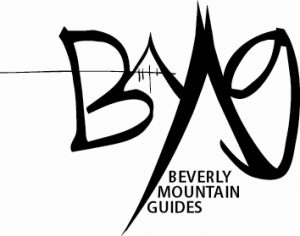
To: All Winter Backcountry Travelers in New Mexico
Re: Backcountry Communications Frequencies
The guides from Beverly Mountain Guides have been working with the communication aspect of our personal and professional operations in the field for the past several years. When COVID hit, and there was a mad dash for backcountry equipment, we knew there was going to be a marked increase in backcountry travelers, especially near trailheads. We therefore markedly increased our avalanche safety education program, but it’s not enough.
Over the past 35 years I have personally seen the New Mexico backcountry scene explode. Up until 20 years ago I rarely, if ever, saw any ski tracks in the backcountry. Now, it is rare for me not to see someone in the backcountry while teaching avalanche courses or ski guiding. As the largest and most expansive backcountry ski guiding company in New Mexico, we feel it is time to add this measure in the wake of recent events.
With the advent of the last several avalanche accidents involving not only multiple parties, but also multiple victims, we have decided that there needs to be radio communications established in NM that will help prevent accidents like those in the neighboring states. WA, UT, and CO have already adopted common frequencies using the Link 1.0 or Link 2.0 by Backcountry Access (BCA).
We will be using the Link Channel D 5.10 for all regular communications in NM. (462.6625, code 94.8)
We will be using the Link Channel E 9.11 for all ongoing search and rescue operations should an avalanche occur.
Calling for help should be performed on Channel D 5.10 as nobody listens to Channel E 9.11 regularly. Formal NM SAR operations function on 155.160 and the BCA Link is not capable of transmitting on this frequency.
To use the channel, simply dial in the frequency for all line of sight transmissions. Blind calls should be made when getting ready to drop in and repeated twice and separated by a :30 sec pause, just in case others did not hear your initial call.
For Example:
“Team of 4 getting ready to drop in on Peace Sign. “
Wait for at least :30 seconds, then repeat when dropping.
“Team of 4 getting ready to drop in on Peace Sign.”
Remember to keep the chatter to a minimum. Other chatter, such as snow conditions, etc., should be on a different frequency.
If you are coming into the runout zone of an avalanche, it’s ok to transmit that you’re crossing a runout zone, but then call “clear” once you’re out of the zone.

If you don’t have a BCA Link, then you can correlate these frequencies with your FCC approved device. If you have a Rocky Talkie you should reference their manual:
Remember to check rules, laws, and regulations, especially if you are using a radio from outside the USA.
We hope that this help averts a disaster that doesn’t need to happen. Until there’s a better plan in place, or until technology improves, we feel that this is a step in the right direction. Please let us know if you happen to find this useful or have had an experience that would have been a near-miss.
For those who are licensed HAM operators, check out this map and this list of frequently used repeaters in NM.
Click Here for the Press Release via KOB TV
Click Here for a great article from Ski Magazine online
Remember that the USFS recommends contacting Search and Rescue as outlined:
- Method of Notification. Requests for medical evacuation, search and rescue, or law enforcement assistance should be directed to the New Mexico State Police:
Santa Fe: 505-827-9300, during business hours 8 a.m.-5 p.m., or 505-827-3476, after-hours emergency,
Espanola: 505-827-9318 or 505-753-2277
Chama: 575-756-2343 or 575-756-1817
Taos: 505-827-9319 or 575-758-8878, or call 911
Doing anything else will surely significantly delay a response.
Best,
James Marc Beverly, PhD, PA-C, IFMGA Mountain Guide
Beverly Mountain Guides, Owner

Press Release copy Click Here
Educational Signage for posting, printing, or passing along Click Here
Below are the corresponding frequencies used for FRS and GMRS radios.



